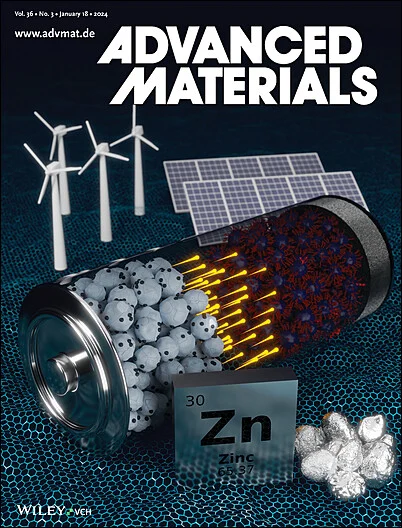Epitaxial Ferroelectric Hexagonal Boron Nitride Grown on Graphene
IF 27.4
1区 材料科学
Q1 CHEMISTRY, MULTIDISCIPLINARY
引用次数: 0
Abstract
Ferroelectricity realized in van der Waals (vdW) materials with non-centrosymmetric stacking configurations holds promise for future 2D devices with nonvolatile and reconfigurable functionalities. However, the epitaxial growth of ferroelectric vdW materials often struggles to achieve an energetically unfavorable stacking configuration that enables electric polarization. This challenge is particularly evident when performing heteroepitaxy on another vdW substrate to create versatile and scalable ferroelectric building blocks designed for large-area, atomic-scale thicknesses. Here, epitaxial hexagonal boron nitride (h-BN) multilayer films are successfully grew on single-crystal graphene synthesized on a miscut SiC (0001) substrate. Theoretical calculations illustrate that the moiré-patterned h-BN/graphene hetero-interface intrinsically exhibits polarization, leading to a polarized AB stacking in multilayer h-BN films to minimize the total formation energy, which is validated experimentally by the layer-dependent band dispersions. The as-grown multilayer h-BN layers demonstrated robust, homogeneous ferroelectricity with switchable out-of-plane polarization via interlayer sliding. This study establishes an effective route for stacking-controlled heteroepitaxy, enabling the large-scale integration of vdW materials with ferroelectricity and versatile functionalities, offering a promising platform for next-generation 2D ferroelectric devices.

求助全文
约1分钟内获得全文
求助全文
来源期刊

Advanced Materials
工程技术-材料科学:综合
CiteScore
43.00
自引率
4.10%
发文量
2182
审稿时长
2 months
期刊介绍:
Advanced Materials, one of the world's most prestigious journals and the foundation of the Advanced portfolio, is the home of choice for best-in-class materials science for more than 30 years. Following this fast-growing and interdisciplinary field, we are considering and publishing the most important discoveries on any and all materials from materials scientists, chemists, physicists, engineers as well as health and life scientists and bringing you the latest results and trends in modern materials-related research every week.
 求助内容:
求助内容: 应助结果提醒方式:
应助结果提醒方式:


